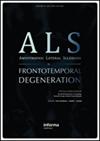修订后的El Escorial标准“临床上可能的实验室支持的ALS”——曾经是一个有希望的类别,现在是多余的类别?
IF 2.5
4区 医学
Q2 CLINICAL NEUROLOGY
Amyotrophic Lateral Sclerosis and Frontotemporal Degeneration
Pub Date : 2020-01-02
DOI:10.1080/21678421.2019.1666875
引用次数: 9
摘要
摘要在过去的二十年里,El Escorial标准(EEC)一直被用作主要随机对照试验的合格标准。修订后的EEC的目标之一是通过引入一个新的类别,即“临床上可能的实验室支持”ALS,允许更早的诊断,从而更早地纳入试验。假设EMG在检测下运动神经元体征方面比临床检查更敏感,则可以将EMG的发现纳入考虑范围。最近,依达拉奉在几个国家获得了治疗ALS的许可,这是基于一项在选定的ALS患者组中进行的随机对照试验,不包括EEC类别的“临床可能实验室支持”。主要原因是在对第一次依达拉奉试验的事后分析中,该组包括许多进展缓慢的患者。由于尚不清楚这种对缓慢进展者的偏见是研究特定的问题还是与类别本身有关,我们在PRO-ACT数据集中进行了分析。在PRO-ACT数据集中,与其他EEC类别(ALSFRS/月-0.68;p < 0.001),并表现出明显更长的诊断延迟(13.5个月vs.11.7个月,p < 0.001)。这表明,在“临床上可能的实验室支持”类别中,对缓慢进展者的偏见是该类别的一个固有问题,因此不能实现早期诊断的先前目标,这引发了关于该类别应用的几个问题。本文章由计算机程序翻译,如有差异,请以英文原文为准。
The revised El Escorial criteria “clinically probable laboratory supported ALS”—once a promising now a superfluous category?
Abstract Over the past two decades, the El Escorial criteria (EEC) have been used as eligibility criteria in major randomized controlled trials. One of the goals of the revised EEC was to allow earlier diagnosis and, thus earlier trial inclusion by introducing a new category, namely “clinically probable laboratory supported” ALS. This category allowed EMG findings to be taken into account assuming that EMG is more sensitive than the clinical examination in detecting lower motor neuron signs. Recently, Edaravone has been licensed in several countries for the treatment of ALS based on a randomized controlled trial in a selected group of ALS patients excluding the EEC category “clinically probable laboratory supported”. The major reason was that in a post hoc analysis of the first Edaravone trial this group comprised many slow progressors. As it is unclear whether this bias towardslow progressors was a study-specific problem or related to the category itself, we performed an analysis in the PRO-ACT dataset. In the PRO-ACT dataset, progression in ALS patients included at baseline into the “clinically probable laboratory supported” category was significantly slower (–0.53 in ALSFRS/month) compared to the other EEC categories (–0.68 in ALSFRS/month; p < 0.001) and exhibited a significantly longer diagnostic delay (13.5 months vs. 11.7 months, p < 0.001). This suggests that the bias toward slow progressors in the “clinically probable laboratory supported” category is an inherent problem of the category and thus does not fulfill the previous goal of earlier diagnosis, raising several questions concerning the application of this category.
求助全文
通过发布文献求助,成功后即可免费获取论文全文。
去求助
来源期刊

Amyotrophic Lateral Sclerosis and Frontotemporal Degeneration
CLINICAL NEUROLOGY-
CiteScore
5.40
自引率
10.70%
发文量
64
期刊介绍:
Amyotrophic Lateral Sclerosis and Frontotemporal Degeneration is an exciting new initiative. It represents a timely expansion of the journal Amyotrophic Lateral Sclerosis in response to the clinical, imaging pathological and genetic overlap between ALS and frontotemporal dementia. The expanded journal provides outstanding coverage of research in a wide range of issues related to motor neuron diseases, especially ALS (Lou Gehrig’s disease) and cognitive decline associated with frontotemporal degeneration. The journal also covers related disorders of the neuroaxis when relevant to these core conditions.
 求助内容:
求助内容: 应助结果提醒方式:
应助结果提醒方式:


